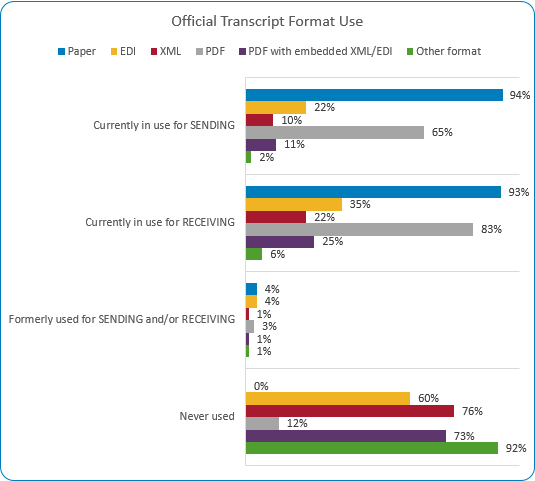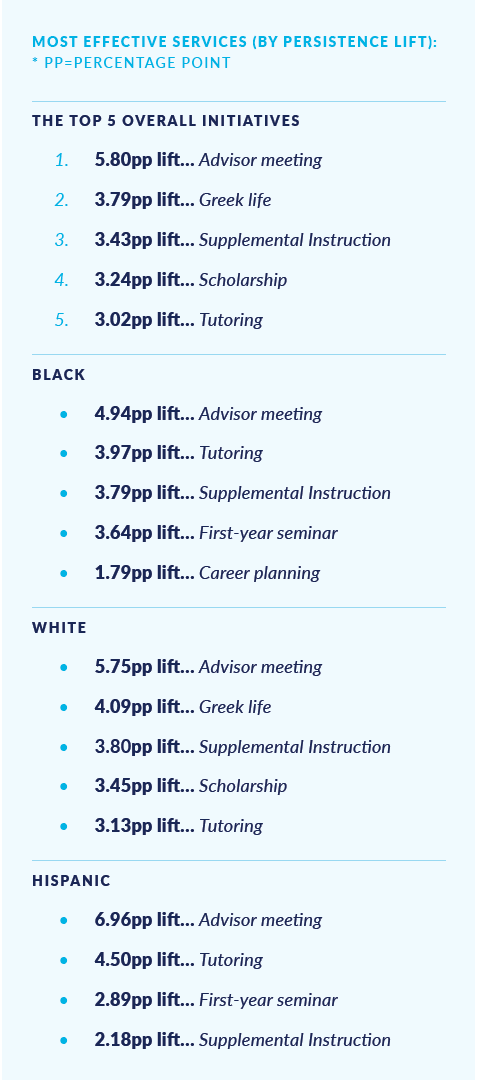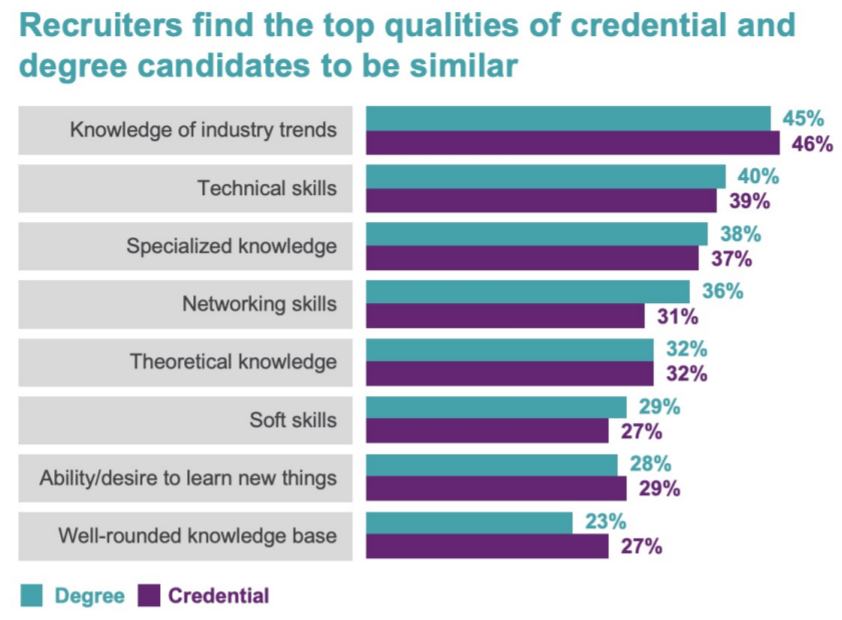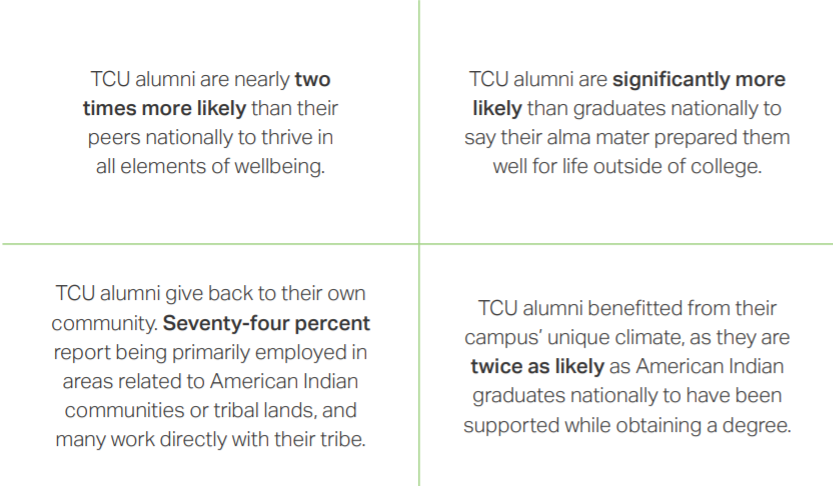Commentary
EDUCAUSE, NACUBO and AIR released a summary of the key themes from their 2019 Enterprise Summit - “Why Data and Analytics Matter and Why They Matter Now.” The emergent themes are:
- The importance of data and the urgency of analytics
- The impact of analytics on the higher education workforce
- Making a difference through communication and governance
EDUCAUSE will dive into each of these themes through a series of
blogs. Much of what they cover in the recommendations in the initial blog mirror what AACRAO has been recommending to institutions and I personally like the way the author has summarized the issues.
I also read an interesting article on the infiltration of chatbots into many areas of higher education. I wonder how many customer service chat experiences I have used are actually a chatbot?
AACRAO Research Update
The two reports highlighted below will soon be available on the AACRAO research
webpage.
60-Second Survey: Official Transcript Formats and Use
AACRAO and the AACRAO SPEEDE Committee are updating electronic transcript data use from research completed in 2011, 2014 and 2017. The committee plans to use the data from this report to inform a College and University article. In addition, we hope to gain an understanding of the barriers to implementation in order to develop recommendations on how to expand the use of electronic education records. The figure below details current transcript format use.

Records and Transcript Practices
The AACRAO academic records and transcript practice survey results shed light on a high degree of variability in transcript and student identity data practices. The fourth iteration of the AACRAO records and official transcript practices survey was conducted in 2019; others were deployed in 2002, 2009 and 2015. This recurring survey serves two functions: 1) as a stand-alone report, it quantifies academic records and transcript practices at U.S. institutions; and 2) it serves as a basis for practice recommendations for the AACRAO publication Academic Records and Transcript Guide. A new version of the book will be released in early 2020. This year, 728 U.S. institutions responded to all or part of the survey, which is a representative sample of U.S. degree granting institutions.
Key findings include:
- Only 5% of respondents to the survey record a student’s full social security number on the transcript, down from 13% in 2015 and 26% in 2002.
- Fewer than one in five institutions include information about a student’s eligibility to re-enroll on the transcript while more than half include probationary information.
- 13% of institutions record both the degree conferred/awarded date and degree completed date.
- 98% of respondents reported that their official transcripts include the signature of the registrar.
- 72% of institutions do not collect a student’s preferred pronoun.
Current Higher Education Research and Related Topics
Student Success Initiatives: An Analysis of What Works
Civitas Learning mined more than 1,500 student success initiatives looking for success and key trends. They found that 60% of initiatives had a statistically significant positive impact. However, 20% of initiatives did not work for some student groups. The trends they uncovered included identifying the most effective services as measured by persistence lift by student subpopulations (see figure below from report).

Students and Hiring Managers/Recruiters Surveyed
Ellucian completed a
survey of 500 hiring managers and students to understand perceptions of college degrees. Key conclusions include:
- More than half of students indicated they were enrolling in college to improve job prospects.
- Some students worry they are not prepared for the workforce, but most employers believe candidates have the skills to succeed.
- Only 35% of all organizations require a college degree for an entry level position
- Hiring managers find the skills and knowledge base of degree earners and credential earners to be similar (see image form report below).

Simulation of Policy Changes on BA Completion
A recently
released BPEA Conference draft paper detailed the results of four simulations used to estimate the impact of policy changes on BA completion at public institutions. The researchers used simulations to measure the impact of the following four policies:
- “Eliminating tuition at two-year colleges”
- “Ensuring sufficient supply of seats at selective public colleges to eliminate under matching within a state”
- “Reducing tuition”
- “Increasing funding for academic support”
The table below is directly from the conference paper and highlights the results of the simulations. Among other conclusions, the policy choice to eliminate tuition at two-year institutions results in an expected decrease in the number of BA graduates. The other policy interventions either indicate a modest improvement in BA graduates or no change.
Nudging to STEM Success (NTSS) Initiative
Jobs for the Future shared the
results of an experiment involving nearly 10,000 community college STEM students. The experiment used text message-based behavioral nudges designed to encourage persistence among students in STEM pathways, with a particular focus on underrepresented students. There was a 16% increase in persistence after the first semester among the students who received nudges compared to those who opted out. Over three terms, these persistence rates held for those who did not subsequently opt out. Students of color who participated persisted at 62% compared to 46% among those who did not. The largest positive effect was observed for adult students (64% vs 44% respectively). In addition, those who paid their tuition early and committed to meet with their advisors persisted at higher rates than those who did neither. Finally, those who reported missing meals due to financial constraints persisted at a much lower rate than those who did not report this issue (69% vs 78%).
Tribal Colleges and Universities (TCU) Alumni Feedback
The American Indian College Fund and Gallup interviewed TCU alumni for a new
report. The report is based on the “largest survey of TCU graduates to date . . .” and compares the results of this survey to the larger college going population. Findings include the following:

Source: Page 2
Three New NCES, NSF and OECD Reports
The National Center for Education Statistics (NCES), the National Science Foundation (NSF), and the Organisation for Economic Co-operation and Development (OECD) released four new data sets and/or reports:
Education Trust: “Broken Mirrors II: Latino Student Representation at Public Colleges and Universities”
Inside Higher Ed
summarized the outcome of the Education Trust’s report. The report concludes that Latinos are underrepresented at community colleges, technical colleges and four-year institutions in most states.
Whole-College Reform and Guided Pathways
The Community College Research Center released a
report and five supporting case studies. The report summarizes field research findings from eight of the participating colleges. The researchers concluded that all of the colleges were successful in implementing large-scale changes in practice. These changes were implemented in essentially the same four phases:
1. “laying the groundwork for whole-college redesign,
2. introducing guided pathways to the college community,
3. supporting collaborative planning and implementation, and
4. sustaining and institutionalizing student success reforms.”
Modeling College Affordability at Public Flagships
A new
report from the Institute for Higher Education Policy (IHEP) includes results of an assessment of affordability for all public flagship institutions. Researchers created five prototypical college students imagined to be from various socioeconomic backgrounds. These model students were used to compare the net price calculator from each institution to see how each would fair in terms of the student’s ability to afford that college. Findings include:
- just six institutions are affordable for low- or middle-income families
- low-income students are expected to pay more than they can afford
- in 34 states, financial aid is offered to those who can already afford the cost of college
- the most affordable institutions enroll very few low-income students
The authors provide five recommendations to promote affordability:
1. “Award state and institutional aid based primarily on student need.
2. Design need-based aid programs to cover the total cost of college, instead of just tuition.
3. Restore and increase general appropriations to all public institutions.
4. Prioritize access for low-income students at public flagships institutions.
5. Design and implement a federal-state partnership to encourage states and institutions to prioritize high-quality, affordable, accessible higher education options for all students.” (page 3)
Community College Bachelor’s Degree Earnings Outlook
Canadian researchers
tracked labor market outcomes linked to community college bachelor degree (CBD) earners compared to university bachelor degree (UBD) earners. They wanted to understand whether or not CBDs and UBDs had the same value to the learner in the labor market and at what rate each pursued graduate studies. They found:
- Two years after graduation, CBD holders earned 12% more per year on average than UBD holders, but this difference could be mostly explained by field of study choice and age of CBD earners.
- This gap in earnings declined over time.
- UBD earners are more likely to pursue graduate studies than CBD earners.
Inside Higher Ed’s Admissions Leaders Report
The 2019 survey of admissions leaders by Inside Higher Ed and Gallup was released on September 23 and summarized in this
article.